Exchange Currency
Latvian lats
The lats (plural: lati or latu) is the currency of Latvia. It is abbreviated as Ls. The lats is subdivided into 100 santīmi (singular: santīms, plural santīmi or santīmu).
Polish money circulated in Latvia while it was part of Poland from 1561 until 1621. After Latvia became part of Sweden, Dalers Silvermynt (SED) and Riksdalers Specie (SES) circulated in Latvia.
Swedish Riksdaler were used in parts of Latvia through 1795. The Riksdaler was issued in silver (Daler Silvermynt-SES), copper and paper format with the exchange rates between the three fluctuating according to the value of silver, copper and the issue of paper banknotes. The Daler was used in Sweden until 1776. Two accounting systems were used in Sweden according to province with some systems based on silver money and some on copper money. The approximate values were 1 Daler equal to 6 Daler Silvermynt, 18 Daler Kopparmynt, 24 Mark, 48 Skilling, 192 Oere or 512 Oerlein. On November 27, 1776, Gustavus III unified the systems of accounting into a single system based upon silver money with 1 Riksdaler Specie (SES) equal to 48 Skilling or 192 Oere. Paper Daler (SEP) and Paper Riksdaler (SER) also circulated, though they usually traded at a discount to specie money.
After being incorporated into Russia, the Ruble was adopted as the medium of exchange in Latvia. Russia had reformed the Ruble (RUEI) under Elizabeth II on November 23, 1755, setting 1 Gold Imperial equal to 10 Silver Rubles or 1000 Copper Kopeks. Paper Assignatzia (Ruble-Banco) also circulated, though usually at a discount to specie money. The monetary system was reformed on July 1, 1839 with 1 Silver Ruble (RUES) set equal to 3.5 Ruble Assignatzia (RUEA). Credit Ruble Banknotes (RUEP) replaced the Ruble Assignatzia on June 1, 1843. Russia went on the Gold Standard on January 3, 1897 and introduced the Gold Ruble, which was used until the outbreak of World War I. The State Treasury and the State Bank (Gosbank) issued banknotes for Russia and the Soviet Union.
Germany occupied parts of Latvia during World War I, and Germany issued both Darlehnskasse Ost Rubles (DEOR), issued by the Ostbank fuer Handel and Gewerbe, and Darlehnskasse Ost Marks (DEOM), issued by the Darlehnskasse Ost, for use in occupied territories, with 1 Mark equal to 2 Rubles. Darlehnskasse Ost Marks were also used in the Baltic State.
After gaining its independence, Latvia issued the Latvian Ruble (LVB) at par with the Russian Ruble. The Lat (LVA) replaced the Latvian Ruble on August 3, 1922 at the rate of 1 Latvian Lat equal to 1 Franc Germinal or 50 Latvian Rubles. The Lat was divisible into 100 Santimi. Banknotes were issued by the Treasury and by the Latvijas Banka (Bank of Latvia). Latvia left the Gold Standard on November 28, 1936.
After the Soviet Union invaded Latvia, the Soviet Gold Ruble (SUG) was introduced as the medium of exchange. During German occupation, Latvia was made part of Ostland. Although a Central Bank for Ostland was established in Riga, no Ostland Marks were ever issued, and Reichskreditkassenschein, along with German Marks, circulated instead. After Latvia was reincorporated into the Soviet Union, a New Ruble (SUN) replaced the Gold Ruble on December 29, 1947 at the rate of 1 New Ruble equal to 10 Gold Rubles. On January 1, 1961, the Hard Ruble (SUR) replaced the New Ruble at the rate of 1 Hard Ruble equal to 10 New Rubles. The Ruble is divisible into 100 Kopeks. Under the Soviet Union, the State Treasury and by the State Bank (Gosbank) issued banknotes.
The second lats was reintroduced in 1993, replacing the Latvian rublis, which was used for a short period after Latvia regained its independence, at a rate of 1 lats = 200 rubļu.
Coins were struck in 1992 by Bayerisches Hauptmünzamt (Germany). Artists: Gunars Lusis (graphic design) and Janis Strupulis (plaster model). In 1997, the 1-santims coin was struck repeatedly by Den Kongelige Mynt (Norway), in 2003, by Monnaie de Paris (France), in 2005 and 2007, by Rahapaja Oy (Finland), in 2008 by Münze Österreich (Austria).
In 2000, the 2-santims coin was struck repeatedly by British Royal Mint (United Kingdom), in 2006 and 2007, by Royal Dutch Mint (the Netherlands), in 2009, by Staatliche Münzen Baden-Württemberg (Germany). In 2006 and 2007, the 5-santims coin was struck repeatedly by British Royal Mint (United Kingdom) and by Münze Österreich (Austria) respectively, in 2009, by Staatliche Münzen Baden-Württemberg (Germany).
In 2008, the 10-santims coin was struck repeatedly by Monnaie de Paris (France). In 2007, the 20-santims coin was struck repeatedly by Real Casa de Moneda (Spain), in 2009, by Staatliche Münzen Baden-Württemberg (Germany).
In 2007 and 2009, the 50-santims coin was struck repeatedly by Staatliche Münzen Baden-Württemberg (Germany). In 2007 and 2008, the 1-lats coin featuring a salmon was struck repeatedly by Monnaie de Paris (France).
Summary info
Summary information about Latvian lats- ISO 4217 Code:
- LVL
- Currency sign:
- Ls
- Country:
- Latvia
- Subunit:
- santīms
- Coins:
- 1 santīms, 2 santīmu, 5 santīmu, 10 santīmu, 20 santīmu, 50 santīmu, 1 lati, 2 lati
- Banknotes:
- 5 latu, 10 latu, 20 latu, 50 latu, 100 latu, 500 latu
- Central bank:
- Bank of Latvia
History
Latvia was originally divided into the smaller states of Livonia, Lettgallia and Courland. In the middle ages what is Latvia today formed part of the state of the Livonian branch of the Teutonic Order.Polish money circulated in Latvia while it was part of Poland from 1561 until 1621. After Latvia became part of Sweden, Dalers Silvermynt (SED) and Riksdalers Specie (SES) circulated in Latvia.
Swedish Riksdaler were used in parts of Latvia through 1795. The Riksdaler was issued in silver (Daler Silvermynt-SES), copper and paper format with the exchange rates between the three fluctuating according to the value of silver, copper and the issue of paper banknotes. The Daler was used in Sweden until 1776. Two accounting systems were used in Sweden according to province with some systems based on silver money and some on copper money. The approximate values were 1 Daler equal to 6 Daler Silvermynt, 18 Daler Kopparmynt, 24 Mark, 48 Skilling, 192 Oere or 512 Oerlein. On November 27, 1776, Gustavus III unified the systems of accounting into a single system based upon silver money with 1 Riksdaler Specie (SES) equal to 48 Skilling or 192 Oere. Paper Daler (SEP) and Paper Riksdaler (SER) also circulated, though they usually traded at a discount to specie money.
After being incorporated into Russia, the Ruble was adopted as the medium of exchange in Latvia. Russia had reformed the Ruble (RUEI) under Elizabeth II on November 23, 1755, setting 1 Gold Imperial equal to 10 Silver Rubles or 1000 Copper Kopeks. Paper Assignatzia (Ruble-Banco) also circulated, though usually at a discount to specie money. The monetary system was reformed on July 1, 1839 with 1 Silver Ruble (RUES) set equal to 3.5 Ruble Assignatzia (RUEA). Credit Ruble Banknotes (RUEP) replaced the Ruble Assignatzia on June 1, 1843. Russia went on the Gold Standard on January 3, 1897 and introduced the Gold Ruble, which was used until the outbreak of World War I. The State Treasury and the State Bank (Gosbank) issued banknotes for Russia and the Soviet Union.
Germany occupied parts of Latvia during World War I, and Germany issued both Darlehnskasse Ost Rubles (DEOR), issued by the Ostbank fuer Handel and Gewerbe, and Darlehnskasse Ost Marks (DEOM), issued by the Darlehnskasse Ost, for use in occupied territories, with 1 Mark equal to 2 Rubles. Darlehnskasse Ost Marks were also used in the Baltic State.
After gaining its independence, Latvia issued the Latvian Ruble (LVB) at par with the Russian Ruble. The Lat (LVA) replaced the Latvian Ruble on August 3, 1922 at the rate of 1 Latvian Lat equal to 1 Franc Germinal or 50 Latvian Rubles. The Lat was divisible into 100 Santimi. Banknotes were issued by the Treasury and by the Latvijas Banka (Bank of Latvia). Latvia left the Gold Standard on November 28, 1936.
After the Soviet Union invaded Latvia, the Soviet Gold Ruble (SUG) was introduced as the medium of exchange. During German occupation, Latvia was made part of Ostland. Although a Central Bank for Ostland was established in Riga, no Ostland Marks were ever issued, and Reichskreditkassenschein, along with German Marks, circulated instead. After Latvia was reincorporated into the Soviet Union, a New Ruble (SUN) replaced the Gold Ruble on December 29, 1947 at the rate of 1 New Ruble equal to 10 Gold Rubles. On January 1, 1961, the Hard Ruble (SUR) replaced the New Ruble at the rate of 1 Hard Ruble equal to 10 New Rubles. The Ruble is divisible into 100 Kopeks. Under the Soviet Union, the State Treasury and by the State Bank (Gosbank) issued banknotes.
The second lats was reintroduced in 1993, replacing the Latvian rublis, which was used for a short period after Latvia regained its independence, at a rate of 1 lats = 200 rubļu.
Coins
Coins were issued in denominations of 1, 2, 5, 10, 20 & 50 santīmu, 1, 2 & 5 lati. The 1, 2 & 5 santīmu were in bronze, the 10, 20 & 50 santīmu were nickel, while coins of 1 lats & above were in silver.Coins were struck in 1992 by Bayerisches Hauptmünzamt (Germany). Artists: Gunars Lusis (graphic design) and Janis Strupulis (plaster model). In 1997, the 1-santims coin was struck repeatedly by Den Kongelige Mynt (Norway), in 2003, by Monnaie de Paris (France), in 2005 and 2007, by Rahapaja Oy (Finland), in 2008 by Münze Österreich (Austria).
In 2000, the 2-santims coin was struck repeatedly by British Royal Mint (United Kingdom), in 2006 and 2007, by Royal Dutch Mint (the Netherlands), in 2009, by Staatliche Münzen Baden-Württemberg (Germany). In 2006 and 2007, the 5-santims coin was struck repeatedly by British Royal Mint (United Kingdom) and by Münze Österreich (Austria) respectively, in 2009, by Staatliche Münzen Baden-Württemberg (Germany).
In 2008, the 10-santims coin was struck repeatedly by Monnaie de Paris (France). In 2007, the 20-santims coin was struck repeatedly by Real Casa de Moneda (Spain), in 2009, by Staatliche Münzen Baden-Württemberg (Germany).
In 2007 and 2009, the 50-santims coin was struck repeatedly by Staatliche Münzen Baden-Württemberg (Germany). In 2007 and 2008, the 1-lats coin featuring a salmon was struck repeatedly by Monnaie de Paris (France).
Banknotes
The Latvian Bank issued notes from 1922 in denominations of 20, 25, 50, 100 and 500 latu. They also issued 10 latu notes which were 500 rubli notes overprinted with the new denomination. The government issued currency notes from 1925 in denominations of 10 and 20 latu.LVL banknotes pictures gallery
| 5 Latvian lati | |
|---|---|
| Banknote of 5 Latvian lati has dimensions 130×65 mm and main colors are camouflage green, ash grey, timberwolf and gray-asparagus. | |
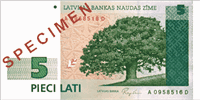 Obverse side of the 5 Latvian lati is showing an oak leaf and an oak tree, ornamental suns and a vertical ornamental band composed of the motif of the Lielvarde belt. |
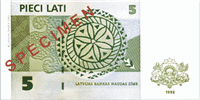 Reverse side of the 5 Latvian lati is showing an ornamental sun cut in wood and a distaff motif. |
| 10 Latvian lati | |
|---|---|
| Banknote of 10 Latvian lati has dimensions 130×65 mm and main colors are palatinate purple, charcoal, old rose, pale chestnut and splashed white. | |
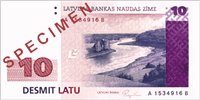 Obverse side of the 10 Latvian lati is showing a panoramic view of the River Daugava and a stylized oak-leaf, which is a see-through register, are superimposed on an ornamental background. |
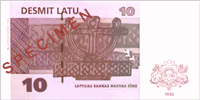 Reverse side of the 10 Latvian lati is showing a representation of the traditional Latvian bronze bow-brooch is superimposed on a motif of the broach's elements. |
| 20 Latvian lati | |
|---|---|
| Banknote of 20 Latvian lati has dimensions 130×65 mm and main colors are persian orange, umber, army green, white, indian yellow and fallow. | |
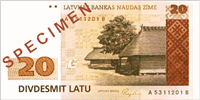 Obverse side of the 20 Latvian lati is showing an ancient Latvian homestead and a stylized oak-leaf, which is a see-through register, are superimposed on an ornamental background. |
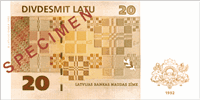 Reverse side of the 20 Latvian lati is showing a motif of traditional Latvian ornaments. |
| 50 Latvian lati | |
|---|---|
| Banknote of 50 Latvian lati has dimensions 130×65 mm and main colors are carolina blue, periwinkle, feldgrau, mint cream and glaucous. | |
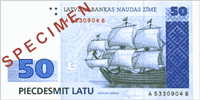 Obverse side of the 50 Latvian lati is showing an ancient sailing-ship and a stylized oak-leaf, which is a see-through register, are superimposed on the fortification plan of the medieval Riga. |
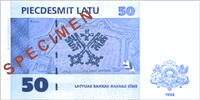 Reverse side of the 50 Latvian lati is showing the historical small coat of arms of Riga, a cross above two intersected keys, is superimposed on the city plan of the medieval Riga. |
| 100 Latvian lati | |
|---|---|
| Banknote of 100 Latvian lati has dimensions 130×65 mm and main colors are antique brass, snow, desert sand, tumbleweed and red-brown. | |
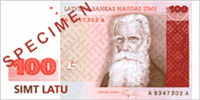 Obverse side of the 100 Latvian lati is showing the portrait of Krisjanis Barons and a stylised oak-leaf (a see-through register) are superimposed on a motif of traditional Latvian ornaments. |
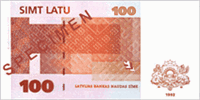 Reverse side of the 100 Latvian lati is showing a variety of Lielvarde belt ornaments. |
| 500 Latvian lati | |
|---|---|
| Banknote of 500 Latvian lati has dimensions 130×65 mm and main colors are pale silver, platinum, white smoke, sand and gainsboro. | |
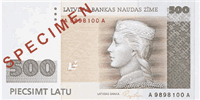 Obverse side of the 500 Latvian lati is showing the profile of a Latvian folk-maid and a stylised oak-leaf (a see-through register) are superimposed on a motif of the ornaments of a bronze head-dress. |
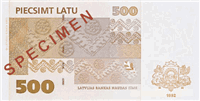 Reverse side of the 500 Latvian lati is showing a motif of the ornaments of a bronze head-dress. |
Useful links
- About Bank of Latvia:
- Bank of Latvia
- List of currencies:
- Currencies
- Security and design features of LVL banknotes:
- LVL banknotes
- LVL currency on Wikipedia:
- Latvian lats
- Official Website of Bank of Latvia:
- www.bank.lv
- Commemorative coins:
- Commemorative Coins